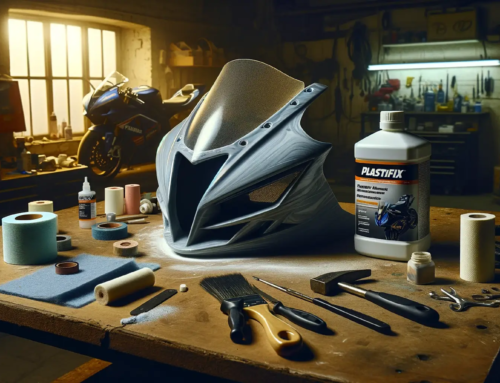So what are motorcycle fairings?
A motorcycle fairing is a specially designed shell placed over the motorcycle’s frame, primarily in the front, around the headlight, and on the sides.
It’s more than a decorative accessory. It’s a functional piece crafted to reduce air drag, protect the rider from airborne hazards, and enhance the bike’s visual appeal. It’s emerged from the racing world, where aerodynamics plays a crucial role. However, their benefits soon paved the way for mainstream motorcycle design.
Historical Evolution
The concept of motorcycle fairings dates back to the early 20th century, with some streamlining evident in racing motorcycles as early as the 1920s.
These early fairings, or cowlings, were initially aimed at increasing the frontal area to improve airflow. Over time, they became an integral part of motorcycle design.
The BMW R100RS, produced from 1976 to 1984, was a pioneering model in the mass-market adoption of full fairings, marking a significant shift in the usage of fairings across different motorcycle types, including sports and touring bikes.
Fairing Types
Motorcycle fairings come in various types, each serving a specific purpose.
- Full Fairings: Cover both the upper and lower portions of the motorcycle, offering maximum aerodynamic benefit and protection. They are common on race and sport bikes.
- Half Fairings: Cover the upper portion of the motorcycle, offering a balance between aerodynamics and a sporty appearance. They are a popular choice for riders who prefer a blend of functionality and style.
- Quarter or Café Fairings: These are minimalist, covering just a portion of the motorcycle’s front, often just around the headlight and handlebars. They are a go-to choice for riders of sportbikes who seek some aerodynamic advantage without the bulk of full fairings.
- Handlebar Fairings: These are attached to the handlebars, offering wind protection to the rider’s hands, and are practical for riders who have devices mounted on the handlebars.
- Belly Pan Fairings: Located at the lower part of the motorcycle, these fairings help in aerodynamics and protect the lower engine components.
- Tail Fairings: Mounted behind the seat and sometimes extending to the sides and below the saddle, often providing a small storage space.
Materials Used in Fairings
The materials used in the construction of fairings have also evolved.
- ABS plastic: known for its strength, flexibility, and lightweight properties, is commonly used in original equipment sport bikes. It can be molded through injection or compression methods, each with its advantages and disadvantages.
- Fiberglass: another popular material, is often used on race tracks due to its light weight and durability.
- Carbon-fiber-reinforced polymer: although the most expensive, is the lightest material used for fairings, preferred in extreme sport and racing motorcycles.
Pros of Motorcycle Fairings
- Enhanced Aerodynamics: Fairings streamline the motorcycle, reducing air drag, which improves speed and fuel efficiency. They are particularly beneficial at high speeds, reducing engine strain and increasing fuel economy.
- Increases Engine Life: By lessening engine strain, fairings contribute to improved efficiency and longer engine life. They also serve as a protective barrier in accidents, safeguarding engine components.
- Downforce & Traction: Fairing winglets create downforce, improving traction and stability at high speeds, essential for safe cornering and stability in crosswinds.
- Protection: Fairing also protects the motorcycle’s inner components, increasing stability for other accessories like GPS and mobiles.
- Rider Comfort and Safety: Fairings protect against wind fatigue, debris, and inclement weather, making the riding experience more comfortable and safer.
- Aesthetic Appeal: Fairing provides a big blank canvas ready to design for personalization with graphics and illustrations.
- Storage Space: Large fairings can increase storage space for long trips and allow for the mounting of additional accessories, such as phones or cameras.
Cons of Motorcycle Fairing
Despite their benefits, motorcycle fairings have several downsides that riders should consider:
- Expensive: Fairings, especially full versions, can be costly, with prices around $1000 or higher. Budget-conscious riders may find them impractical.
- Increased Front Width: Full fairings add to the bike’s frontal width, complicating navigation through narrow spaces and tight parking.
- Maintenance Challenges: Fairings, particularly full ones, can obstruct access to parts of the bike, making maintenance more time-consuming and potentially leading to extra costs for professional services.
- Uncomfortable Riding Position & Handling: Fairings often necessitate a forward-leaning riding position, which can be uncomfortable over long periods. They can also affect the handling of standard motorcycles or cruisers.
These disadvantages vary in impact from rider to rider and should be weighed against the benefits when considering a fairing for your motorcycle.
Conclusion
Motorcycle fairings are a blend of form and function, integral to the modern motorcycle design. Whether for speed, style, or comfort, they play a pivotal role in enhancing the riding experience. As technology advances, we can expect even more innovative designs in the future.















